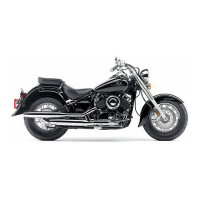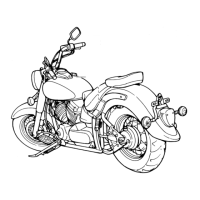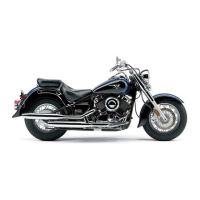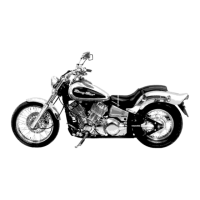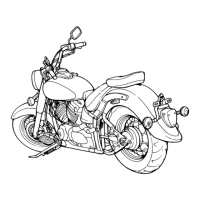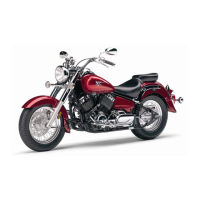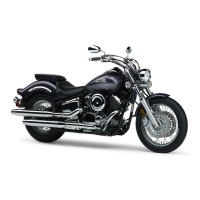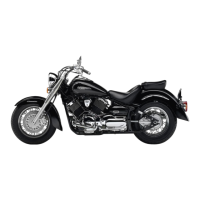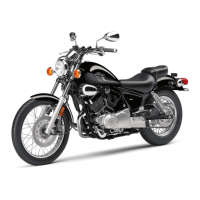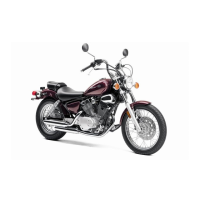Do you have a question about the Yamaha V-star XVS650P and is the answer not in the manual?
Explains the meaning of symbols like WARNING, CAUTION, and NOTE for critical information.
Emphasizes reading the manual and obtaining training for safe operation and enjoyment.
Covers essential practices for safe motorcycle operation, including visibility and hazard awareness.
Details the importance of helmets, protective clothing, and avoiding loose garments.
Warns against unauthorized modifications that can compromise safety and legality.
Provides guidelines for safely adding accessories or cargo to maintain stability and handling.
Addresses hazards associated with gasoline and exhaust fumes, including flammability and toxicity.
Illustrates the positions of crucial safety and information labels on the motorcycle.
Identifies key components visible from the left side of the XVS650 model.
Identifies key components visible from the right side of the XVS650 model.
Identifies key components visible from the left side of the XVS650A model.
Identifies key components visible from the right side of the XVS650A model.
Provides an overview and identification of the motorcycle's controls and instrument panel features.
Operation of main switch, steering lock, and ignition circuit cut-off system.
Describes warning lights, indicators, speedometer, odometer, and tripmeter functions.
Details operation of handlebar switches, clutch lever, and brake lever.
Explains operation of shift pedal, brake pedal, and fuel cock.
Covers fuel tank cap, fueling, fuel cock, and storage compartment access.
Guides on using the choke for starting and procedures for removing/installing seats.
Details helmet holder, sidestand operation, and shock absorber preload adjustment.
Describes the safety functions of the ignition circuit cut-off system, including sidestand and clutch switches.
A comprehensive list of items to check before operating the motorcycle for safety and proper function.
Guides on safely starting and warming up the engine before riding.
Instructions for starting the engine when it is already warm.
Explains how to shift gears for acceleration, deceleration, and climbing hills.
Details how to safely slow down and stop the motorcycle using brakes and downshifting.
Provides a table of recommended speeds for shifting gears during acceleration and deceleration.
Crucial advice for the initial 1,000 miles to ensure engine longevity and performance.
Instructions on how to safely park the motorcycle, including engine shutdown and precautions.
Highlights maintenance benefits, emission controls, and the owner's tool kit.
Covers emission control, general maintenance charts, and panel removal/installation.
Details spark plug checks, engine oil, filter, final gear oil, and air filter maintenance.
Covers tire, brake, and suspension adjustments, checks, and fluid levels.
Explains lubrication for cables, levers, pedals, and sidestand for smooth operation.
Guides on tire inspection, wheel bearing checks, and spoke wheel maintenance.
Covers battery information, fuse replacement, and bulb replacement procedures.
Offers guidance on diagnosing and resolving common operational problems.
Provides instructions and precautions for cleaning the motorcycle to prevent rust and corrosion.
Guides on how to properly store the motorcycle for short or extended periods to preserve its condition.
Lists key physical dimensions, engine type, displacement, and oil specifications.
Details fuel type, tank capacity, carburetor model, and spark plug specifications.
Provides tire sizes, types, load limits, and recommended air pressures for both models.
Lists specifications for wheels, brakes, suspension travel, electrical systems, and battery.
Lists the voltage, wattage, and quantities for various bulbs and the ratings for fuses.
Explains where to find and record key and vehicle identification numbers for reference and security.
Indicates the location of the model label on the frame for identifying spare parts.
Advises owners on how to report potential safety defects to the National Highway Traffic Safety Administration.
Outlines regulations regarding tampering with noise control systems on motorcycles.
Explains the importance of keeping maintenance records for warranty purposes.
Details the terms and conditions of the manufacturer's limited warranty for street and enduro motorcycles.
Describes the benefits and coverage options available through the Yamaha Extended Service plan.
Explains the meaning of symbols like WARNING, CAUTION, and NOTE for critical information.
Emphasizes reading the manual and obtaining training for safe operation and enjoyment.
Covers essential practices for safe motorcycle operation, including visibility and hazard awareness.
Details the importance of helmets, protective clothing, and avoiding loose garments.
Warns against unauthorized modifications that can compromise safety and legality.
Provides guidelines for safely adding accessories or cargo to maintain stability and handling.
Addresses hazards associated with gasoline and exhaust fumes, including flammability and toxicity.
Illustrates the positions of crucial safety and information labels on the motorcycle.
Identifies key components visible from the left side of the XVS650 model.
Identifies key components visible from the right side of the XVS650 model.
Identifies key components visible from the left side of the XVS650A model.
Identifies key components visible from the right side of the XVS650A model.
Provides an overview and identification of the motorcycle's controls and instrument panel features.
Operation of main switch, steering lock, and ignition circuit cut-off system.
Describes warning lights, indicators, speedometer, odometer, and tripmeter functions.
Details operation of handlebar switches, clutch lever, and brake lever.
Explains operation of shift pedal, brake pedal, and fuel cock.
Covers fuel tank cap, fueling, fuel cock, and storage compartment access.
Guides on using the choke for starting and procedures for removing/installing seats.
Details helmet holder, sidestand operation, and shock absorber preload adjustment.
Describes the safety functions of the ignition circuit cut-off system, including sidestand and clutch switches.
A comprehensive list of items to check before operating the motorcycle for safety and proper function.
Guides on safely starting and warming up the engine before riding.
Instructions for starting the engine when it is already warm.
Explains how to shift gears for acceleration, deceleration, and climbing hills.
Details how to safely slow down and stop the motorcycle using brakes and downshifting.
Provides a table of recommended speeds for shifting gears during acceleration and deceleration.
Crucial advice for the initial 1,000 miles to ensure engine longevity and performance.
Instructions on how to safely park the motorcycle, including engine shutdown and precautions.
Highlights maintenance benefits, emission controls, and the owner's tool kit.
Covers emission control, general maintenance charts, and panel removal/installation.
Details spark plug checks, engine oil, filter, final gear oil, and air filter maintenance.
Covers tire, brake, and suspension adjustments, checks, and fluid levels.
Explains lubrication for cables, levers, pedals, and sidestand for smooth operation.
Guides on tire inspection, wheel bearing checks, and spoke wheel maintenance.
Covers battery information, fuse replacement, and bulb replacement procedures.
Offers guidance on diagnosing and resolving common operational problems.
Provides instructions and precautions for cleaning the motorcycle to prevent rust and corrosion.
Guides on how to properly store the motorcycle for short or extended periods to preserve its condition.
Lists key physical dimensions, engine type, displacement, and oil specifications.
Details fuel type, tank capacity, carburetor model, and spark plug specifications.
Provides tire sizes, types, load limits, and recommended air pressures for both models.
Lists specifications for wheels, brakes, suspension travel, electrical systems, and battery.
Lists the voltage, wattage, and quantities for various bulbs and the ratings for fuses.
Explains where to find and record key and vehicle identification numbers for reference and security.
Indicates the location of the model label on the frame for identifying spare parts.
Advises owners on how to report potential safety defects to the National Highway Traffic Safety Administration.
Outlines regulations regarding tampering with noise control systems on motorcycles.
Explains the importance of keeping maintenance records for warranty purposes.
Details the terms and conditions of the manufacturer's limited warranty for street and enduro motorcycles.
Describes the benefits and coverage options available through the Yamaha Extended Service plan.
| Displacement | 649cc |
|---|---|
| Bore x Stroke | 81.0mm x 63.0mm |
| Compression Ratio | 9.0:1 |
| Ignition | TCI |
| Transmission | 5-speed |
| Final Drive | Shaft |
| Front Suspension | Telescopic fork |
| Front Brake | Single disc |
| Rear Tire | 170/80-15 |
| Engine Type | Air-cooled, SOHC, V-twin |
| Rear Suspension | Swingarm |
| Rear Brake | Drum |
| Fuel Capacity | 16 litres (3.5 imp gal; 4.2 US gal) |
| Ground Clearance | 140 mm |
| Front Tire | 130/90-16 |
